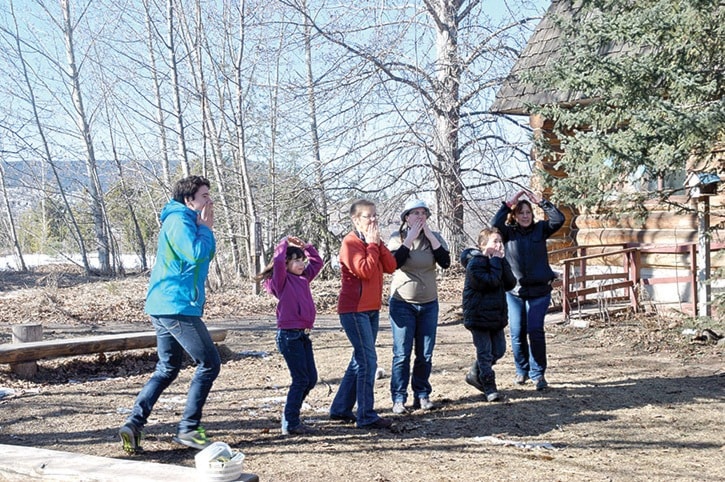Did you know that the alpha wolves (the mating mom and dad) in a pack holds their tails higher than the other wolves?
These are some of the facts Mary Forbes explained to nearly 40 parents and children participating in the special Family Wolf Day on a recent Saturday at Scout Island Nature Centre.
The adventure is one of many provided for children, students and their families by the Williams Lake Field Naturalists who will be holding their 2015 Scout Island Nature Centre Fund Raising Banquet at St. Andrew’s United Church on April 24.
Wolves communicate in some ways that are known, such as talking using noises that dogs typically make plus howling, the way they move their ears, scent markings, playful and aggressive body postures, Forbes explained.
And they may communicate in even more subtle ways that researchers may not know much about such as using their paws or the way their fur moves.
Participants played some games outside where they learned about a wolf’s basic needs for food, water, and shelter and how humans learned the art of hunting by watching wolves who use group strategies to hunt down and capture their prey.
Inside Forbes involved the group in a version of the “Simon Says” game called “Alpha Says.”
In the game Forbes demonstrates how wolves show curiosity with their ears straight up and submissiveness with their ears laid back.
A posture with paws out and back end up indicates they want to play similar to dogs who want to play called a “Play Bow.”
Forbes notes that young wolves stay with their families for about a quarter of their lives to learn all the skills they need to succeed as adults. This is about the same relative time in human years, that children stay and learn with their families.
Forbes showed the group a wolf pelt and explained that wolves are tall animals with narrow chests and big feet so they can move quickly and efficiently through forests and over deep snow.
She also played a game with the group where the children were challenged to match the wolf skull and other skulls lined up on a table with the appropriate pictures by comparing the shape of the heads and teeth to pictures of the animals.
Skulls to examine included that of a cougar kitten, bear, fox, beaver, and of course wolf.
She also talked a bit about wolf control, habitat and how if the alpha wolves are killed it can cause havoc in the system because the teenage wolves haven’t yet learned all the skills they need to succeed.
She explained that killing the alpha wolves will result in splintered packs, more wolves being taught by wolves who themselves didn’t get a complete education and may turn to hunting domestic stock instead of wild game to feed themselves.
She also talked about a wolf researcher named Sadie Parr from Wolf Awareness Inc www.wolfawarenessinc.org recently working in the Brittany Triangle near the Nemiah Valley, and with local ranchers, who is studying wolf scat to better understand what wolves eat at the various times of the year.
